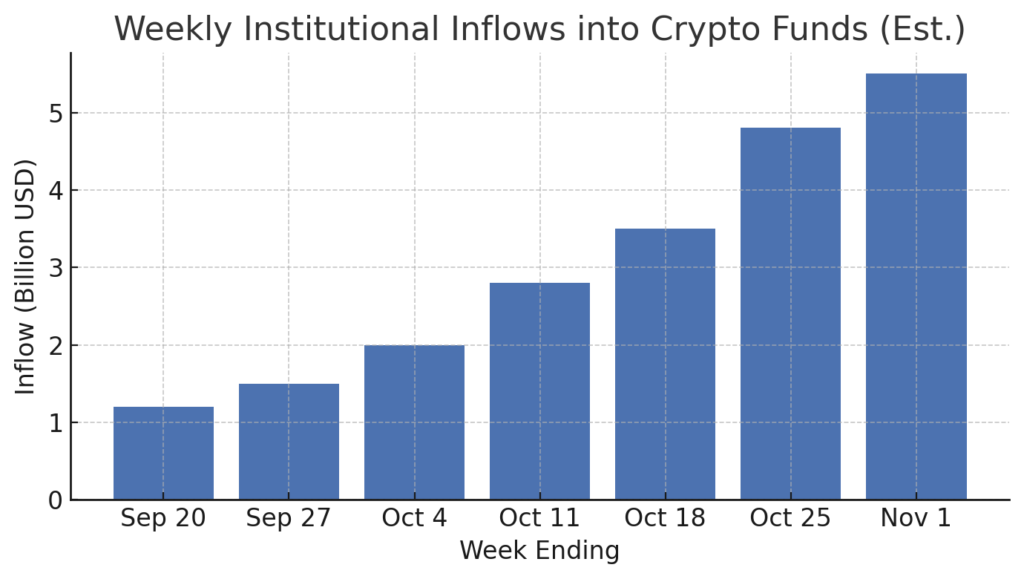
Main Points :
- The U.S. and China have reached a sweeping trade agreement that removes tariffs, ends non-tariff barriers and eases export controls—setting the stage for a renewed “risk on” environment.
- For the crypto markets, this shift could unlock institutional capital as macro uncertainty around trade diminishes and liquidity conditions brighten.
- Key catalysts include lowered rare-earth export restrictions (which affect mining hardware supply), soybean purchases from China (improving U.S. farm economy), and U.S. tariff reductions scheduled for November 10.
- While optimism is growing, actual execution of the deal and macro context (monetary policy, dollar strength) remain critical.
- For crypto investors seeking new assets, this could mean renewed momentum for large-cap coins (Bitcoin, Ethereum) and tokenised commodities or supply-chain tokens tied to rare-earths and manufacturing.
- Caution is warranted: recent data still show mixed flows and some “sell‐the‐news” behaviour in crypto markets.
1. The Trade Deal and Macro Landscape
In early November 2025, the governments of the United States and China announced a broad trade agreement. China committed to suspend all retaliatory tariffs and non-tariff measures imposed since March 4, and U.S. tariffs on Chinese goods are to be cut by 10 percentage points starting November 10. China will also guarantee purchase obligations of U.S. soybeans—at least 12 million tons by end of year, and up to 25 million tons annually until 2028. In addition, China will cease new export controls on rare-earths and other key minerals used in tech manufacturing. According to the Kobeissi Letter, this is “the past largest de-escalation yet”.
This deal comes at a moment when global equity flows are surging and risk assets are gaining appeal. For example, global equity funds took in US$10.58 billion in net inflows in the week ending October 29 amid expectations of a U.S. Federal Reserve rate cut and the trade deal. The reduced uncertainty from trade friction also supports a backdrop of improving liquidity and risk-on sentiment.
2. Why Crypto Might Benefit
For the crypto and blockchain space, several mechanisms tie into this macro-trade event:
a) Eased supply-chain pressure
Rare-earths and important minerals are critical inputs for semiconductor, EV, and mining-rig industries. Export restrictions from China had raised costs and uncertainty for manufacturing hardware used in crypto mining and for tokenised commodity projects. With those restrictions easing, hardware supply may stabilize and input costs fall—this improves fundamentals for mining operations and infrastructure firms in the crypto ecosystem.
b) Institutional capital shift
With major geopolitical risk (U.S.–China trade war) receding, institutional investors may feel more comfortable increasing allocations to alternative assets, including digital assets. The removal of a large tail-risk event (tariff escalation or export bans) reduces one reason to sit on the sidelines. One research piece noted that the trade deal “creates space for institutional investors to increase crypto allocations without fearing sudden shocks.”
c) Liquidity and risk-assets rotation
Lower interest rates, improved risk-sentiment and inflows into equities suggest a broader “risk-on” regime. Crypto often behaves as a risk-asset and can benefit when liquidity is abundant. For example, bitcoin rose to about US$115,600 following trade-deal optimism.
3. Market Response and Technical Behaviour

Despite optimism, markets are showing caution.
- According to one analysis, while the trade deal is positive, the market has not yet celebrated: the “fear index” for crypto remains mid-30s/40s (rather than extreme greed), meaning positioning is not yet frothy.
- Some reports suggest “sell-the-news” behaviour: after the announcement and a Fed rate cut, the crypto market dropped US$80 billion in 24 hours and bitcoin slid to ~US$110,000.
- Long-term holders in bitcoin have increased net distribution, and some large wallets are moving coins, injecting additional supply.
- One newsletter stated that while the trade deal removes the immediate tariff threat, major capital inflows into crypto remain sidelined until deal implementation is verified.
4. Implications for Crypto Project Seekers & Income-Focused Investors

For our audience—seeking new crypto assets, revenue opportunities, and practical blockchain applications—this development offers avenues:
● Large-cap opportunistic repositioning. With macro tail risks receding, coins like Bitcoin and Ethereum may serve as entry points for institutions. The space may benefit from structural tailwinds such as ETF inflows (bitcoin spot ETFs year-to-date have gathered ~$30 billion).
● Tokenised commodity and supply-chain plays. Given the removal of rare-earth export restrictions, blockchain projects tied to commodity tokens, manufacturing hardware supply chains, and decentralised resource-tracking could gain renewed interest. Investors may explore tokens representing physical-asset flows or supply-chain transparency.
● Mining & infrastructure businesses. Lower input cost risk and improved stability may support margin expansion for crypto-mining firms. If hardware supply improves, mining profitability could rebound, which in turn strengthens the overall crypto ecosystem.
● Cautious timing and risk management. Despite optimism, the “deal” is only part of the story. Implementation is key. Investors may prefer to wait for confirmatory signals (e.g., China begins shipments of rare-earths, U.S. actually lowers tariffs). The market has already shown some “sell-the-news” reaction; therefore momentum may hinge on follow-through rather than headline alone.
5. What to Monitor Going Forward
To make the most of this environment, here are key variables to track:
- China’s compliance: Does it suspend all retaliatory tariffs & export controls as promised? Deviations may spook markets.
- U.S. tariff reductions: Implementation date (Nov 10) and sectors impacted.
- U.S. dollar and interest rate trends: A strong dollar can weigh on crypto; conversely, further Fed cuts/liquidity may help.
- Institutional flows: Spot bitcoin ETF activity, crypto fund flows, stablecoin float.
- Mining hardware cost & supply: If rare-earth and chip supply eases, mining margins improve, which is positive for network security and investor sentiment.
- Technical patterns: For bitcoin, a break above US$120,000 or a failure could set the tone for year-end run.
6. Conclusion
The U.S.–China trade agreement marks a significant de-escalation in one of the world’s largest geopolitical risk vectors. For the crypto market, this could lift a persistent overhang of trade-shock risk and pave the way for renewed institutional participation, improved liquidity and structural tailwinds.
For investors targeting new crypto assets and blockchain applications, the key takeaway is: the macro backdrop may be improving, making large-cap coins, commodity-linked tokens and mining/infrastructure plays more attractive. However, the devil is in the details—deal implementation, monetary policy, and technical market dynamics remain crucial. Prudence suggests positioning now with conviction but also retaining flexibility, since timing matters and the “momentum window” may be narrow.
In short, the trade truce may be the ignition—how quickly the crypto engine accelerates will depend on execution, flows and sentiment alignment.

